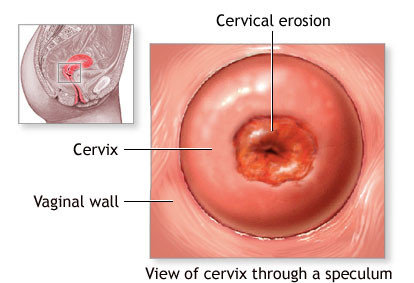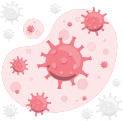Definition
Cervical ectropion, or cervical erosion, is a condition where the cells that are normally inside the cervix appear or grow outside the cervix. The inside and outside of the cervix are composed of two types of cells: the outer cervix has flat, pale pink squamous cells (harder cells), while the inner cervix has finger-like projections covered by glandular cells, similar to the lining of the digestive tract.
In cervical ectropion, the harder squamous cells of the outer cervix intermingle with the softer glandular cells of the inner cervix, creating an inflamed, red, and infected area. This condition is commonly seen in young women with hormonal changes and can be observed during a Pap smear (cervical screening) when the outer cervix appears red. Cervical ectropion is not dangerous and is not associated with the development of cervical cancer.
Causes
Cervical ectropion is associated with increased levels of the hormone estrogen, which significantly affects the cervix and causes the growth of cervical epithelial cells.
Risk Factor
Several factors can increase the risk of developing cervical ectropion, including:
- Sexually Transmitted Infections (STIs), such as herpes and syphilis
- Douching or cleansing the vagina with a mixture of various chemicals
- Adolescence
- Pregnancy
- Hormonal contraception
- Early onset of menstruation
This condition is rare in postmenopausal women. During menopause, estrogen levels drop, causing the cervix to shrink and drawing the squamous epithelium from the outer cervix into the endocervical canal.
Read more about sexually transmitted infections here: Sexually Transmitted Infections - Definition, Causes, Symptoms, and Treatment
Symptoms
In general, cervical ectropion is symptomless. Doctors can detect signs of cervical ectropion during a routine pelvic exam or Pap smear. Although typically asymptomatic, cervical ectropion can sometimes present with symptoms such as:
- Vaginal discharge, which can be mucus or blood
- Pain and bleeding during or after sexual intercourse
- Pain and bleeding during a pelvic exam
- Light bleeding (spotting) between menstrual periods
- Pelvic pain
Diagnosis
Cervical ectropion often does not cause symptoms, so it is usually discovered during a doctor's examination. To diagnose cervical ectropion, the doctor will perform:
Medical Interview
The doctor will ask about:
- Current symptoms
- Menstrual history
- Health history
- Use of hormonal contraceptives
Physical Examination
After the medical interview, the doctor will measure vital signs such as blood pressure, respiratory rate, pulse, and body temperature. An additional physical exam may include a pelvic examination. During this exam, the cervix will appear bright red and rougher than usual and may cause light bleeding.
Additional Examinations
Additional examinations, if needed, include:
- Pap smear: a procedure to collect and examine cervical cells, aiming to detect cervical cancer early
- Colposcopy: using a lighted instrument called a colposcope to view the cervix more closely
- Biopsy: taking a tissue sample to check for abnormal cells that may indicate cancer
Early-stage cervical cancer can look like cervical ectropion. A Pap smear can help diagnose cervical cancer. If you have no symptoms and your Pap smear results are normal, further tests are unnecessary. However, if you have other symptoms, such as pain during intercourse, heavy bleeding, or vaginal discharge, the doctor may recommend additional tests to find the cause.
Management
Cervical ectropion often does not require treatment. However, if it is accompanied by symptoms like mucus or blood discharge or spotting from the vagina, medication to reduce symptoms, such as boric acid, may be prescribed.
The primary treatment for cervical ectropion is cauterization to prevent abnormal discharge or bleeding. Methods for obtaining this include:
- Diathermy: a small device that delivers heat to the cervical cells to relieve symptoms.
- Cryotherapy: delivering cold to freeze inflamed cells.
- Silver Nitrate: applying silver nitrate to the cervix to treat bleeding cells.
These procedures are performed with local anesthesia, allowing you to return to normal activities quickly. You may experience mild discomfort similar to menstrual cramps for a few hours to a few days and might have some discharge or spotting for a few weeks.
For more intensive procedures to treat severe cervical ectropion, you may need a longer recovery period, avoiding sexual intercourse and using tampons for about 4 weeks to prevent infection. The doctor will provide follow-up instructions and examination schedules.
Complications
If not properly treated, infections associated with cervical ectropion can develop into more severe infections requiring prolonged treatment. In some individuals, bleeding may be heavy rather than just spotting, leading to anemia (a condition where the body lacks enough red blood cells).
Prevention
To prevent cervical ectropion, consider the following steps based on its risk factors:
- Maintain hygiene of the vaginal area
- Clean from front to back to prevent bacteria from the anus from moving to the vagina
- Avoid douching, as washing the vagina with water or chemical mixtures can disrupt the bacterial balance, making you more susceptible to STIs
- Use condoms during sexual intercourse
When to See a Doctor?
Consult a doctor if you experience:
- Foul-smelling vaginal discharge
- Abnormal bleeding
- Pain during or after sexual intercourse
- Pelvic pain not related to menstrual cramps
If you have any of these conditions, seek medical advice promptly.
If you want to know more about pelvic inflammatory disorder, you can read it here: Pelvic Inflammatory Disorder - Definition, Cause, Symptoms And Treatment Diseases
Looking for more information about other diseases? Click here!
- dr. Monica Salim
Cervical Ectropion (2022). Retrieved 19 December 2022, from https://my.clevelandclinic.org/health/diseases/23053-cervical-ectropion#:
Cervical Ectropion. (2022). Retrieved 19 December 2022, from https://www.ncbi.nlm.nih.gov/books/NBK560709/
What Is Cervical Ectropion. (2021). Retrieved 19 December 2022, from https://www.webmd.com/cancer/cervical-cancer/cervical-ectropion
What Is Cervical Ectropion (Cervical Erosion)?. Retrieved 19 December 2022, from https://www.healthline.com/health/womens-health/cervical-ectropion
Cervical Ectropion. (2022). Retrieved 19 December 2022, from https://www.cuh.nhs.uk/patient-information/cervical-ectropion/
Cervical Ectropion : Symptoms, Causes, and Treatment. (2022). Retrieved 19 December 2022, from https://www.verywellhealth.com/cervical-ectropion-overview-3522327







